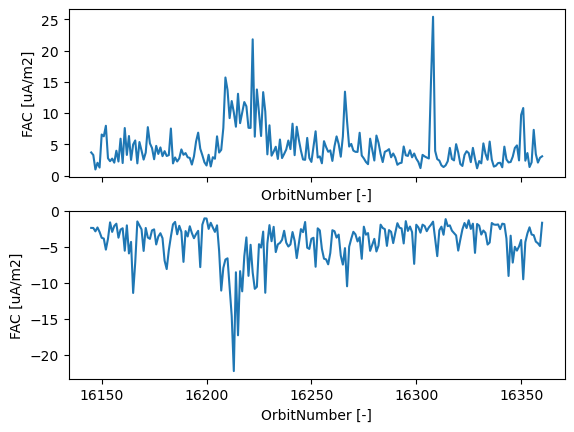FAC_TMS_2F (dual spacecraft)#
Abstract: Access to the field aligned currents evaluated by the dual satellite method (level 2 product). We also show an orbit-by-orbit plot using a periodic axis to display (centred over both poles) an overview of the FAC estimates over two weeks.
See also:
%load_ext watermark
%watermark -i -v -p viresclient,pandas,xarray,matplotlib
Python implementation: CPython
Python version : 3.11.6
IPython version : 8.18.0
viresclient: 0.14.1
pandas : 2.1.3
xarray : 2023.12.0
matplotlib : 3.8.2
from viresclient import SwarmRequest
import datetime as dt
import numpy as np
import pandas as pd
import matplotlib.pyplot as plt
import matplotlib.dates as mdates
request = SwarmRequest()
FAC_TMS_2F product information#
This is derived from data from both Swarm Alpha and Charlie by the Ampère’s integral method
Documentation:
Check what “FAC” data variables are available#
NB: these are the same as in the FACxTMS_2F single-satellite FAC product
request.available_collections("FAC", details=False)
{'FAC': ['SW_OPER_FACATMS_2F',
'SW_OPER_FACBTMS_2F',
'SW_OPER_FACCTMS_2F',
'SW_OPER_FAC_TMS_2F',
'SW_FAST_FACATMS_2F',
'SW_FAST_FACBTMS_2F',
'SW_FAST_FACCTMS_2F']}
request.available_measurements("FAC")
['IRC',
'IRC_Error',
'FAC',
'FAC_Error',
'Flags',
'Flags_F',
'Flags_B',
'Flags_q']
Fetch one day#
Also fetch the quasidipole (QD) coordinates at the same time.
request.set_collection("SW_OPER_FAC_TMS_2F")
request.set_products(
measurements=["FAC", "FAC_Error",
"Flags", "Flags_F", "Flags_B", "Flags_q"],
auxiliaries=["QDLat", "QDLon"],
)
data = request.get_between(
dt.datetime(2016,1,1),
dt.datetime(2016,1,2)
)
data.sources
['SW_OPER_FAC_TMS_2F_20160101T000000_20160101T235959_0401']
Load as a pandas dataframe:
df = data.as_dataframe()
df.head()
| Longitude | QDLon | FAC | Latitude | Radius | Flags | Flags_q | FAC_Error | QDLat | Spacecraft | Flags_B | Flags_F | |
|---|---|---|---|---|---|---|---|---|---|---|---|---|
| Timestamp | ||||||||||||
| 2016-01-01 00:00:00.500 | 93.510970 | 104.164139 | 0.044131 | -72.499886 | 6.833866e+06 | 0 | 404 | 0.039584 | -81.265083 | - | 2002 | 22222224 |
| 2016-01-01 00:00:01.500 | 93.539666 | 103.824883 | 0.034081 | -72.563053 | 6.833867e+06 | 0 | 404 | 0.039720 | -81.299690 | - | 2002 | 22222224 |
| 2016-01-01 00:00:02.500 | 93.568594 | 103.483047 | 0.025312 | -72.626215 | 6.833868e+06 | 0 | 404 | 0.039856 | -81.334015 | - | 2002 | 22222224 |
| 2016-01-01 00:00:03.500 | 93.597756 | 103.138550 | 0.019080 | -72.689371 | 6.833870e+06 | 0 | 404 | 0.039993 | -81.368042 | - | 2002 | 22222224 |
| 2016-01-01 00:00:04.500 | 93.627155 | 102.791489 | 0.014609 | -72.752521 | 6.833871e+06 | 0 | 404 | 0.040132 | -81.401764 | - | 2002 | 22222224 |
Depending on your application, you should probably do some filtering according to each of the flags. This can be done on the dataframe here, or beforehand on the server using request.set_range_filter(). See https://earth.esa.int/documents/10174/1514862/Swarm-L2-FAC-Dual-Product-Description for more about the data
Load as xarray dataset (we will use this instead of the pandas dataframe)
ds = data.as_xarray()
ds
<xarray.Dataset>
Dimensions: (Timestamp: 86400)
Coordinates:
* Timestamp (Timestamp) datetime64[ns] 2016-01-01T00:00:00.500000 ... 201...
Data variables:
Spacecraft (Timestamp) object '-' '-' '-' '-' '-' ... '-' '-' '-' '-' '-'
Longitude (Timestamp) float64 93.51 93.54 93.57 ... -94.65 -94.65 -94.65
Flags_B (Timestamp) uint32 2002 2002 2002 2002 ... 2002 2002 2002 2002
QDLon (Timestamp) float64 104.2 103.8 103.5 ... -24.03 -24.03 -24.03
FAC (Timestamp) float64 0.04413 0.03408 ... -0.009214 -0.008928
Latitude (Timestamp) float64 -72.5 -72.56 -72.63 ... 31.55 31.61 31.68
Radius (Timestamp) float64 6.834e+06 6.834e+06 ... 6.823e+06 6.823e+06
Flags (Timestamp) uint32 0 0 0 0 0 0 0 0 0 0 0 ... 0 0 0 0 0 0 0 0 0 0
Flags_q (Timestamp) uint32 404 404 404 404 404 404 404 ... 0 0 0 0 0 0 0
FAC_Error (Timestamp) float64 0.03958 0.03972 0.03986 ... 0.01702 0.01702
QDLat (Timestamp) float64 -81.27 -81.3 -81.33 ... 41.33 41.39 41.45
Flags_F (Timestamp) uint32 22222224 22222224 ... 22222224 22222224
Attributes:
Sources: ['SW_OPER_FAC_TMS_2F_20160101T000000_20160101T235959_0401']
MagneticModels: []
AppliedFilters: []Plot the time series#
ds["FAC"].plot(x="Timestamp");
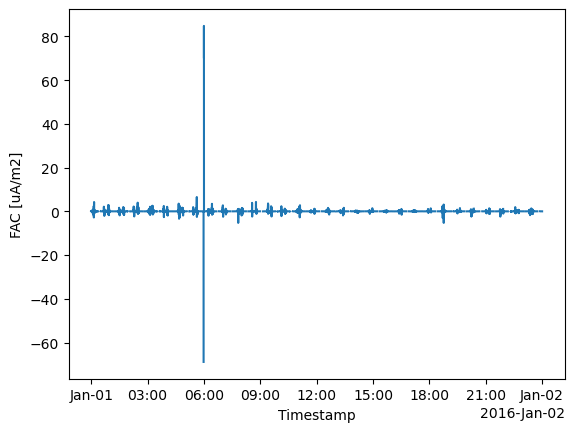
fig, axes = plt.subplots(ncols=1, nrows=2, figsize=(15,5))
axes[0].plot(ds["Timestamp"], ds["FAC"])
axes[1].plot(ds["Timestamp"], ds["FAC_Error"], color="orange")
axes[0].set_ylabel("FAC\n[$\mu A / m^2$]");
axes[1].set_ylabel("Error\n[$\mu A / m^2$]");
axes[1].set_xlabel("Timestamp");
date_format = mdates.DateFormatter('%Y-%m-%d\n%H:%M')
axes[1].xaxis.set_major_formatter(date_format)
axes[0].set_ylim(-5, 5);
axes[1].set_ylim(0, 1);
axes[0].set_xticklabels([])
axes[0].grid(True)
axes[1].grid(True)
fig.subplots_adjust(hspace=0.1)
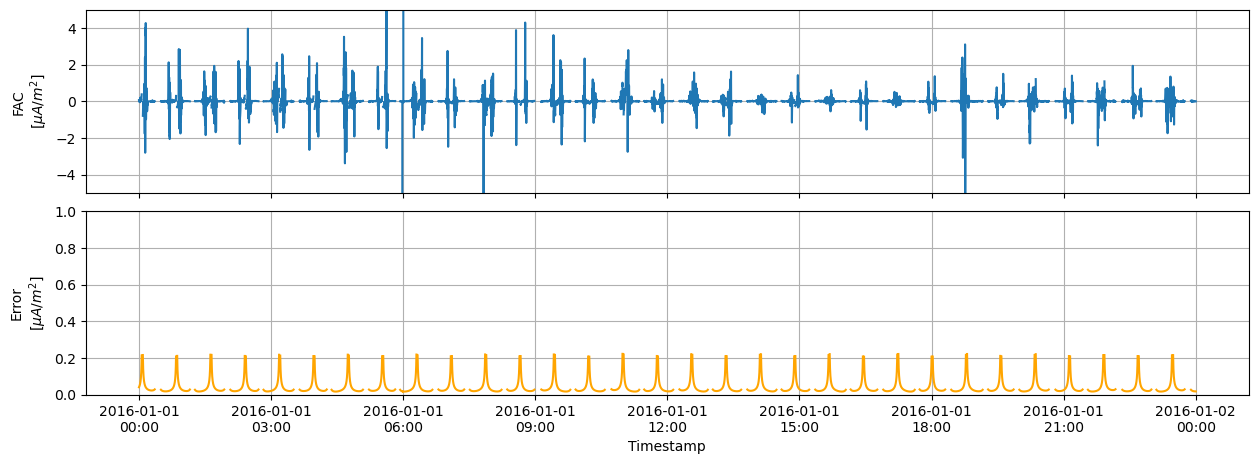
Note that the errors are lower than with the single satellite product
“2D” plotting of two weeks using periodic axes#
Identify a stormy period between 2016.0 and 2018.0#
# Fetch Dst over this period
# NB this is just a convenient way to fetch Dst in this notebook
# Not really a good way to do it in general
start_time = dt.datetime(2016,1,1)
end_time = dt.datetime(2018,1,1)
request = SwarmRequest()
request.set_collection("SW_OPER_FAC_TMS_2F")
request.set_products(
measurements=[],
auxiliaries=["Dst"],
sampling_step="PT120M"
)
ds_dst = request.get_between(start_time, end_time).as_xarray()
# Count the occurences of Dst < -50 nT each month
ds_dst["Dst"].where(ds_dst["Dst"]<-50).resample({"Timestamp": "1m"}).count().plot();
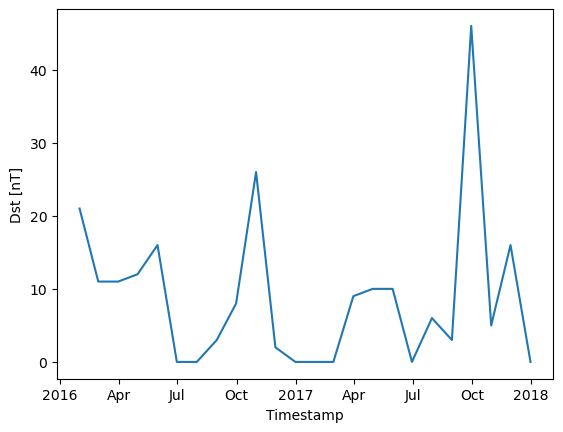
# Plot Dst from that peak month to then choose a two-week period from it
ds_dst["Dst"].sel({"Timestamp": slice("2016-10-01","2016-10-30")}).plot();
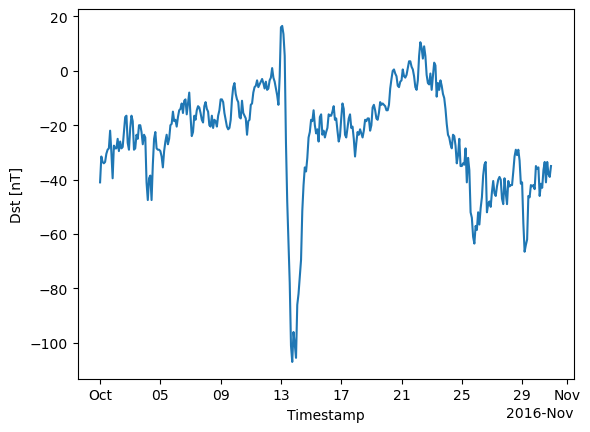
Fetch the data from the chosen time period#
start_time = dt.datetime(2016,10,9)
## If you want an exact number of days:
end_time = start_time + dt.timedelta(days=14)
request = SwarmRequest()
request.set_collection("SW_OPER_FAC_TMS_2F")
request.set_products(
measurements=["FAC", "Flags"],
auxiliaries=["QDLat", "QDLon", "MLT",
"OrbitNumber", "QDOrbitDirection"],
sampling_step="PT10S"
)
data = request.get_between(start_time, end_time)
ds = data.as_xarray()
# NB OrbitNumber is not available for the dual satellite product because it is ambiguous
ds
<xarray.Dataset>
Dimensions: (Timestamp: 120960)
Coordinates:
* Timestamp (Timestamp) datetime64[ns] 2016-10-09T00:00:00.500000 ... 201...
Data variables:
Spacecraft (Timestamp) object '-' '-' '-' '-' '-' ... '-' '-' '-' '-' '-'
Longitude (Timestamp) float64 -36.08 -22.38 -9.023 ... -136.8 -136.7
MLT (Timestamp) float64 4.921 4.836 4.768 4.711 ... 15.82 15.8 15.78
QDLon (Timestamp) float64 144.5 143.2 142.2 ... -51.77 -52.08 -52.38
FAC (Timestamp) float64 nan nan nan ... -0.01751 -0.02754 -0.0245
Latitude (Timestamp) float64 87.29 87.34 87.23 ... -43.95 -43.31 -42.67
Radius (Timestamp) float64 6.811e+06 6.811e+06 ... 6.829e+06 6.829e+06
Flags (Timestamp) uint32 104400000 104400000 ... 4400000 4400000
QDLat (Timestamp) float64 85.1 84.52 83.94 ... -40.14 -39.54 -38.94
Attributes:
Sources: ['SW_OPER_FAC_TMS_2F_20161009T000000_20161009T235959_040...
MagneticModels: []
AppliedFilters: []Complex plotting setup (experimental)#
# Functions to produce periodic axes
# Source: https://github.com/pacesm/jupyter_notebooks/blob/master/Periodic%20Axis.ipynb
from matplotlib import pyplot as plt
from numpy import mod, arange, floor_divide, asarray, concatenate, empty, array
from itertools import chain
import matplotlib.cm as cm
from matplotlib.colors import Normalize, LogNorm, SymLogNorm
from matplotlib.colorbar import ColorbarBase
class PeriodicAxis(object):
def __init__(self, period=1.0, offset=0):
self.period = period
self.offset = offset
def _period_index(self, x):
return floor_divide(x - self.offset, self.period)
def periods(self, offset, size):
return self.period * arange(self._period_index(offset), self._period_index(offset + size) + 1)
def normalize(self, x):
return mod(x - self.offset, self.period) + self.offset
# def periodic_plot(pax, x, y, xmin, xmax, *args, **kwargs):
# xx = pax.normalize(x)
# for period in pax.periods(xmin, xmax - xmin):
# plt.plot(xx + period, y, *args, **kwargs)
# plt.xlim(xmin, xmax)
# def periodic_xticks(pax, xmin, xmax, ticks, labels=None):
# ticks = asarray(ticks)
# labels = labels or ticks
# ticks_locations = concatenate([
# ticks + period
# for period in pax.periods(xmin, xmax - xmin)
# ])
# ticks_labels = list(chain.from_iterable(
# labels for _ in pax.periods(xmin, xmax - xmin)
# ))
# plt.xticks(ticks_locations, ticks_labels)
# plt.xlim(xmin, xmax)
class PeriodicLatitudeAxis(PeriodicAxis):
def __init__(self, period=360, offset=-270):
super().__init__(period, offset)
def periods(self, offset, size):
return self.period * arange(self._period_index(offset), self._period_index(offset + size) + 1)
def normalize(self, x):
return mod(x - self.offset, self.period) + self.offset
def periodic_latscatter(pax, x, y, ymin, ymax, *args, **kwargs):
yy = pax.normalize(y)
xmin = kwargs.pop("xmin")
xmax = kwargs.pop("xmax")
for period in pax.periods(xmin, xmax - xmin):
plt.scatter(x, yy + period, *args, **kwargs)
plt.ylim(ymin, ymax)
def periodic_yticks(pax, ymin, ymax, ticks, labels=None):
ticks = asarray(ticks)
labels = labels or ticks
ticks_locations = concatenate([
ticks + period
for period in pax.periods(ymin, ymax - ymin)
])
ticks_labels = list(chain.from_iterable(
labels for _ in pax.periods(ymin, ymax - ymin)
))
plt.yticks(ticks_locations, ticks_labels)
plt.ylim(ymin, ymax)
def fac_overview_plot(ds):
fig, axes = plt.subplots(figsize=(16, 8), dpi=100)
tmp1 = array(ds['QDLat'][1:])
tmp0 = array(ds['QDLat'][:-1])
pass_flag = tmp1 - tmp0
latitudes = tmp0
times = array(ds['Timestamp'][:-1])
values = array(ds['FAC'][:-1])
# # Subsample data
# pass_flag = pass_flag[::10]
# latitudes = latitudes[::10]
# times = times[::10]
# values = values[::10]
plotted_latitudes = array(latitudes)
descending = pass_flag < 0
plotted_latitudes[descending] = -180 - latitudes[descending]
vmax = 20
plax = PeriodicLatitudeAxis()
periodic_latscatter(
plax, times, plotted_latitudes, -190, 190,
xmin=-360-90, xmax=360+90, c=values, s=1,
# https://matplotlib.org/tutorials/colors/colormapnorms.html#symmetric-logarithmic
cmap=cm.coolwarm, norm=SymLogNorm(linthresh=0.1, linscale=1, vmin=-vmax,vmax=vmax)
)
cax = plt.colorbar()
cax.ax.set_ylabel("FAC [$\mu A / m^2$]")
plt.xlim(times.min(), times.max())
plt.xlabel("time")
plt.ylabel("QD-latitude / deg")
periodic_yticks(plax, -190, +190, [-225, -180, -135, -90, -45, 0, 45, 90], labels=[
'+45\u2193', '0\u2193', '\u221245\u2193', '\u221290', '\u221245\u2191', '0\u2191', '+45\u2191', '+90'
])
return fig, axes
fac_overview_plot(ds);
/opt/conda/lib/python3.11/site-packages/numpy/ma/core.py:4348: RuntimeWarning: invalid value encountered in subtract
self._data.__isub__(other_data)
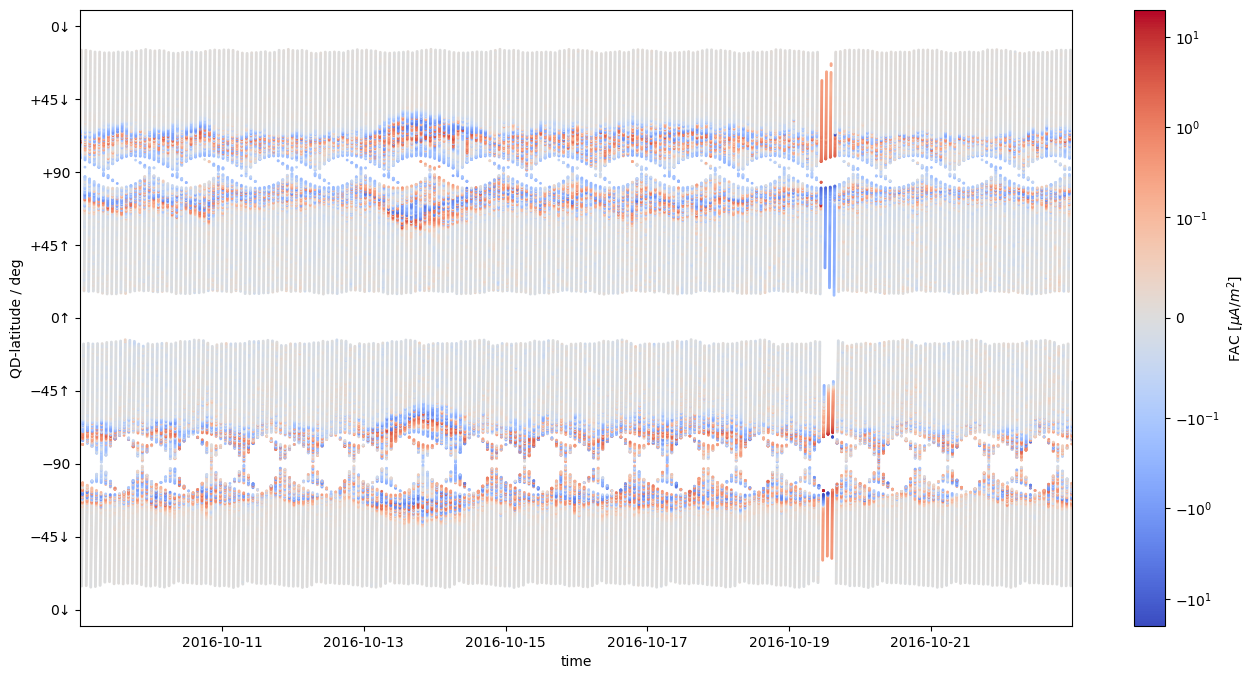
# Maximum values for FAC indicate saturation of the colorbar
ds["FAC"].max(), ds["FAC"].min()
(<xarray.DataArray 'FAC' ()>
array(65.4033561),
<xarray.DataArray 'FAC' ()>
array(-60.04496457))
A few other views of the data#
# Flags indicate something wrong around 2016-10-19
fig, axes = plt.subplots(nrows=2, sharex=True, figsize=(20,5), dpi=200)
ds["FAC"].plot(ax=axes[0])
ds["Flags"].plot(ax=axes[1]);

ds.plot.scatter(y="FAC", x="QDLat", s=1, linewidths=0);
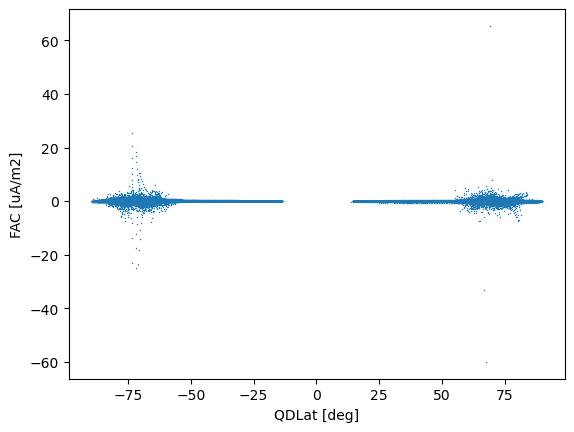
fig, ax = plt.subplots(figsize=(15,5), dpi=200)
ds.plot.scatter(
ax=ax,
x="MLT", y="QDLat", hue="FAC", cmap=cm.coolwarm, s=1, linewidths=0,
norm=SymLogNorm(linthresh=0.1, linscale=1, vmin=-20, vmax=20),
);
/opt/conda/lib/python3.11/site-packages/numpy/ma/core.py:4348: RuntimeWarning: invalid value encountered in subtract
self._data.__isub__(other_data)
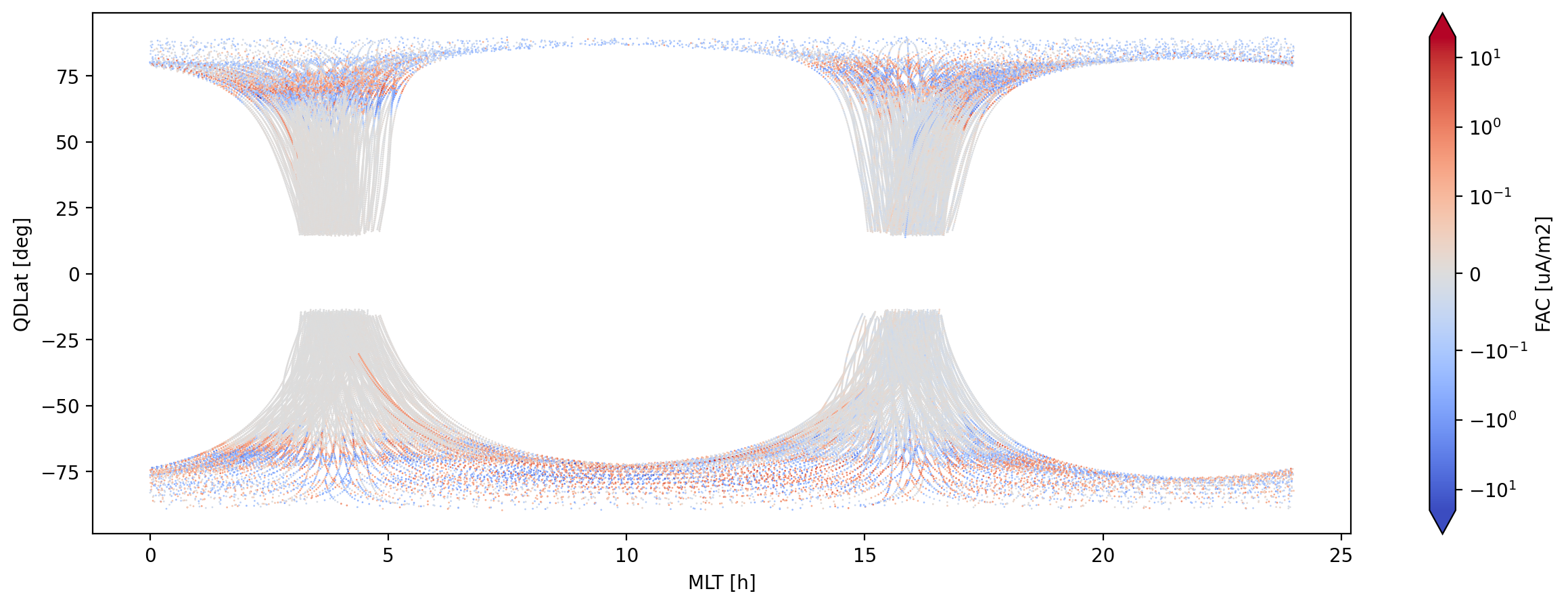
# Plotting the maximum FAC encountered on each orbit
# Do this with the single satellite product instead for now
# so that we can quickly use the OrbitNumber parameter
# which is not available for the dual-sat product
# You could achieve this by generating a flag based on
# zero-crossings of Latitude
start_time = dt.datetime(2016,10,9)
end_time = start_time + dt.timedelta(days=14)
request = SwarmRequest()
request.set_collection("SW_OPER_FACATMS_2F")
request.set_products(
measurements=["FAC", "Flags"],
auxiliaries=["QDLat", "QDLon", "MLT",
"OrbitNumber", "QDOrbitDirection"],
sampling_step="PT10S"
)
data = request.get_between(start_time, end_time)
ds = data.as_xarray()
fig, axes = plt.subplots(nrows=2, sharex=True)
ds.groupby("OrbitNumber").max()["FAC"].plot(ax=axes[0])
ds.groupby("OrbitNumber").min()["FAC"].plot(ax=axes[1]);
